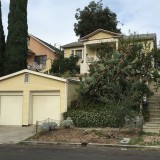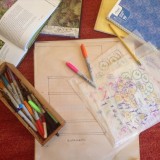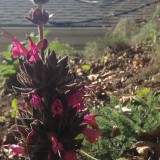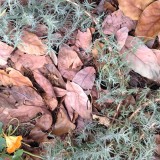
Erik’s Sketchup rendering of the front yard.
In my previous post, I discussed the history of this little patch of slope which we’re trying to redesign. Now I’ll talk about the ideas behind the redesign.
What do you do with a slope?
Our front yard has always been a bit of a puzzler, because it tilts up. I’ve envied folks with flat front yards, because you can sit in them. You can host a party out front. Our slope has always seemed like a space which we had to take care of–but which wasn’t very fun or useful. It’s not built to be accessible by humans (which makes working on it real fun.) That might be one reason why the idea of making it into an orchard had so much appeal.
When garden design books bother to address hillside gardens, they always feature much bigger hills than ours, and these hills feature expensive hardscaping, like artfully arranged imported boulders, fancy staircases which sweep along the contour of the hill, or dazzling water features. Nobody designs in 15 foot wide spaces stuffed between a staircase and a garage. There’s just not a lot of room in our yard for sweeping gestures. I’m afraid our space is inescapably boxy, dorky and pokey.
I’ve tried to imagine what could be done with this space if we had unlimited funds and the help of a talented designer. I suspect they’d want to remove our very utilitarian, straight-up and down staircase and make a new staircase which would sweep down the hill in a series of dynamic switch-backs. It would be lovely, I’m sure. I can see it in my mind’s eye. But because we don’t want to go into debt to have a nice front yard, we’re stuck with the ho-hum layout we have now.
“Good enough”
And speaking of being stuck, we made the decision at this point, when we were ripping everything out, not to upgrade our retaining walls. There are currently three retaining walls on the slope, made of railway ties. They are not attractive, and they are slowly rotting. On the upside, though, they are fairly invisible, as they are the color of dirt.
The prudent thing to do would have been to dig out trenches, pour concrete footings and make really solid walls out of cinder block or a specialized retaining wall system. This we could do ourselves, if we wanted to do spend two or three weeks in backbreaking labor–and if we didn’t mind the prison-yard aesthetic of those heavy walls.
The dream alternative would be stacked river rock retaining walls, done by professionals, which was out of our budget. We thought about learning how to do stacked rock on our own, but our local supply yard’s rock was both ugly and expensive.
We waffled over all of this and many other alternatives for for a good while, then finally threw up our hands and gave up trying to be responsible. We replaced one very rotten expanse of wood and Erik hammered in a few piece of metal bar to stabilize the more wobbly sections and called it good enough.
This “good enough” attitude has been a hallmark of many of our home improvement projects, and it does not always end up being such a great strategy. However, sometimes good enough really is good enough–which is why we continue to try to get away with it. So I don’t know about this one. Time will tell. For now, I’m praying we’ll get the new plants’ root systems established before the heavy rains hit.

The primal landscape? Elephants on the Serengeti (Image courtesy of the Wikimedia Commons)
The concept of legibility
One term used by Rainer and West in Planting in a Post-Wild World that I really glommed onto was “legibility.” Landscapes have to be legible to be likeable.
The Western world has an inherited bias toward open landscapes with clean edges. In its simplest incarnation, a lawn with a tree. The driveway and the clipped hedge. The golf course. This may be an aesthetic inheritance of those grand, Romantic-period English estates featuring expanses of rolling green turf dotted with picturesque trees– an aesthetic that has shaped what we think parks and suburban yards should look like–no matter where we live.
Some people think this bias may even go back to our earliest ancestral memories–to the savannas, where we liked long, clear views so we could spot both dangers and opportunities easily–and handy trees to scramble into if we needed to get away from a predator.
Whatever the reason, we like open spaces which are easily read and understood. This can take many forms, but we definitely have a preference for savannas, open meadows, and forests with pleasingly spaced upright trees but very little undergrowth. We don’t like landscapes which are dense or tangled or “wild” looking. We don’t like too many shrubs. We don’t like over-exuberant plants–plants tall enough to loom over us. We don’t like plants which block our views.
In one of his books (and unfortunately I don’t remember which one) the great plant designer Piet Oudolf talked about how he quite likes to use big looming plants for the air of mystery and drama they can add to a garden, but admits that most clients feel threatened by them, and recommends they usually be kept out in the back forty where they won’t alarm us.
To get back to my slope, I found all this quite interesting, because the slope presented many legibility issues. Truth be told, as of a couple of weeks ago, there was actually zero legibility on our slope. As I explained in the last post, there was a big cactus blocking all views up from the street, but from the house and the stairs, you saw the struggling fruit trees and the tangle of undergrowth beneath them. Nothing made sense. Nothing was pleasing or soothing to the eye.
I walked around the neighborhood looking at other people’s slopes, searching for inspiration. Our neighborhood is hilly, so there are plenty of other people dealing with this same problem. Most of the yards are smallish, too, like ours. Unfortunately (and here is where I suddenly become very unpopular with the neighbors!) I didn’t find any inspirational models my walks. Instead, I saw the same problems over and over.
Legibility was a problem in many yards. The majority of slopes were planted with shrubbery, as we did in our yard’s first incarnation. Almost everybody has planted drought tolerant plants, whether those were California natives or Mediterranean plants.
The plus side of this strategy is that your yard is not thirsty, and some of those plants feed insects, and best of all, those plants are pretty low maintenance. The downside — and this was a big revelation to me–is that slopes planted this way are not legible. They function as one big mass of lion-hiding shrubbery.
It’s particularly bad on the upward facing slopes, where the plants, though they may only three feet tall, loom high above us when we’re standing down on the sidewalk. There are no clear sight lines. There is no composition for the eye to rest in. There’s just a bunch of fairly undifferentiated lumpy plant matter blocking your view of the house.
I realized that at a subconscious level, lack of legibility is unnerving. It sounds silly, but it really is uncomfortable. I found I don’t like to stand at the bottom of these shrub planted slopes and look up into their mysterious depths–even though I am a plant nerd, and enjoy identifying and admiring individual plants, I’d just say hi to the plants and move on pretty briskly. It didn’t even matter if the shrubs were pruned into lumpy bumpy topiary or allowed to grow into one another. The feeling was the same.
So, clearly, I wasn’t going to swap our failed orchard for another go around with shrubbery–not even for native sages, which I adore. Instead, I began to think in terms of a vertical meadow.
The meadow
Strangely, landscapes based on meadows/grasslands/prairies have yet to really catch on in California. I understand from my readings that they’ve been popular in other places for a good twenty years or so. I have no idea why California is dragging its heels. The upshot, though, is that I don’t have many good models of what a California meadow would look like, especially not a specifically Southern California meadow which also happens to be drought tolerant.
There were natural grasslands in Southern California, once upon a time, before they were grazed down to nubbins and replaced by Bermuda grass. I don’t know what my neighborhood looked like before the colonists arrived. It was farmland before it was developed into housing in 1920. Prior to that it may have been a ranch–it seems likely, since most of LA was ranch land.
What it was before the Spanish put sheep and cows on it, I don’t know, but it could very well have been rolling grassland dotted with oaks. It may have been exactly the kind of highly legible, savanna-esque landscape our hearts yearn for. (The native peoples of California liked this type of landscape, too, it seems. They ate lots of wildflowers and acorns, so they encouraged/developed sunny meadows dotted with spreading oaks.) But we won’t ever know what was here. The very hill that our house sits on may be artificial.
Notions of historic legacies aside, I liked the idea of designing our yard as a sloped meadow (vertical grassland?) for a couple of reasons. The first, obviously, is the legibility factor. I wanted low growing plants which were as “non-threatening” as a bland, low ground cover like ivy, but varied and lovely as well, plants which would invite the eye to linger and explore. The meadow would allow the eye to find its way to the top of the slope, where we have a fine pomegranate tree to stand in for one of those reassuring savanna trees. Our slope is a small boxed-in space, so can never feel as expansive as a genuine open meadow, but I hope it will feel restful.
Also, I wanted the biodiversity that a meadow invites. As Rainer and West point out, we can never hope to match the diversity of the wild, where hundreds of species will co-exist simultaneously in well-developed meadow communities, but we can do our best. We can strive for as much diversity as possible, and not fall prey to modernist notions of simplicity. For instance, I could plant the entire slope with purple grass and spiky blue agaves. That would be visually striking. It would be tidy. It would be fairly easy to design. People driving past might say, “Such pretty colors!”
But a landscape consisting of a total of two species is an unfriendly, selfish sort of landscape, one which is far more about form than function. I wanted to choose plants which would feed birds and pollinators all year long. I wanted the slope to be welcoming place for all sorts of little critters to rest or feed or make their home. I wanted to foster the life of the soil. I wanted the slope to be bountiful. Yet I also wanted it to be attractive to humans.
Balancing these two goals–serving the natural world and appeasing the aesthetic sensibilities of a public habituated to lawn and roses– can be a bit of a challenge, but I think this is an important, necessary challenge. This is the challenge Planting in a Post Wild World is addressing.
This is the cutting edge of landscape design.
And I’m trying to pull it off as a DIY project with no help beyond a good book and the Internet.
Yeah. So what’s new?
Sorry for the cliffhanger, but this series is turning epic! Next post we’ll delve into the design principles I used to chose my plants.






This is a very good post. Thanks for opening up your design process. The question of legibility as it pertains to your site reminds me of the peach orchard in Kurosawa’s “Dreams”. It is a kind of stage with space flattened vertically into shelves. Each shelf having an independent set of players that have a strong relationship to each other a looser relationship to the whole. Check it out, and feel good about the space you have.
It seems like you want too much out of this small space. I don’t mind and really like towering plants/trees. My yard has oaks, hickories and pine. So, I work on understory (around 20 feet tall)and ground-hugging plants. It may be all wrong, but it suits me.
Looking at your front yard, I am impressed with the lack of shade. So, I would probably want blueberries or something low and edible. Since my yard has too much shade for many things, I just like anything low that likes shade.
I have seen yards that are unimpressive that border on what-were-they-thinking. I am impressed with your research and what people are saying about landscaping.
I remember seeing a picture of a terraced hillside that was stunning. I think it was a blend of salvias, lavenders, grasses, and probably some other things. None of it was so high to be shrubby and overbearing and the effect was quite lovely.
Have you guys though about putting a swale in at the top to help groundwater collect and seep down your hillside?
Have you looked at California native plant society http://www.cnps.org/? They seem to have a lot of good resources.
Thanks so much for your posts. We have been struggling with this too and after five years part of yard looks good, but the largest part looks terrible. I really like the term “legible” because I think that is what we are missing. We broke down and hired a designer (specializing in California natives), but are waiting for the design.
You mentioned the 15 foot width of each portion of the slope, but what’s the depth? For some reason, I really see a small cafe-style table and two chairs on the second level from the street – a place to have coffee and waive hello to the neighbors.
A table and chairs would be nice! But the second terrace, the widest one, is too steep, and the other two are too narrow. (The slope is about 20 feet deep–more if you include the area at the very top.
Is that a kitty on the steps?
Funny–it does look like a cat! It’s actually a mailbox.
Sweeping staircases may look good, but as a route to your front door a straight line is probably more practical anyway.
Anybody coming to your door will naturally want to take the shortest route (including you carrying bags of shopping probably) and will be tempted to cut the corners of a zigzag. You could put in a smaller recreational path or stepping stones to access a seating area, perhaps?
Oh, don’t worry–we won’t change the stairs! And another commenter suggested seating as well–it’s a very good idea in the abstract, but it doesn’t work with the site as is–which would make sense if you guys could see the slope from the stairs.
We went through this exact process when we bought our house in a near suburb of minneapolis. With the house came a dead lawn, miserable suffocating juniper shrubs and cumbersome layers of rock and plastic surrounding the foundation. I know it sounds strange, but our land felt wounded…raw and in need of healing. I am now a native plant purist; a decision I made in order to support the organisms which co-evolved with many plants whose habitat is dissappearing rapidly in the midwest. I researched heavily the ecotype of our area, and also learned about microclimates to “restore” the yard to reflect an oak savannah with native forbs, grasses, small shrubs, trees and woodland ephemerals. I realize this is a microscopic effort in the big scheme of things, but in just 3 years since I started, the presence of wildlife has increased exponentially. Our .25 acre lot teems with life, and interestingly enough our basement spider problem went away. I keep our gardens aesthetically in-check with consistent edging, manicured turf (whats left of it – and it shrinks yearly) and meticulous weeding (plant i.d. became my obsession!). Sorry to ramble on here; this post really struck a chord with my own experience. Best of luck, can’t wait to read more!
I don’t think it sounds strange at all to say that it felt as if your land is wounded. It was wounded. We are indoctrinated by our materialist culture to feel foolish if we experience empathy for plants and subtle living systems like soil. I ache when I see something destructive and stupid going on, like someone butchering a tree instead of pruning it properly, or trees dying because of lack of water, or someone covering a yard with gravel and plastic. Yet at the same time, my indoctrinated self says, “It’s their property, it’s none of your business, it’s just a tree.” The thing is, I just don’t believe the indoctrinated voice anymore.
Anyway, your yard sounds lovely and wonderful. I’d love to see all our yards like that–welcoming to wildlife, abundant, diverse. You’re a model to your neighbors, and that is an excellent thing. Smart too, for you to keep it in check with edging and a little turf. Those gestures go a long way toward helping the neighbors accept less traditional landscaping.